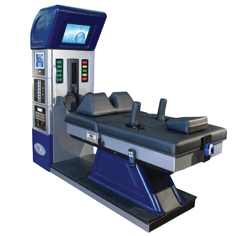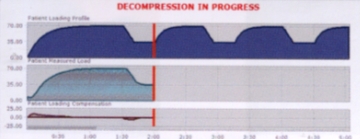medicine
www.normanallan.com
416 928 9272
alternative medicine | Norman
Allan www.normanallan.com | consultations 416 928 9272 | ||
by Norman Allan © I just got up-dated (somewhat) and the whole story is a mess... lots of "buyer beware" here. Research it carefully (maybe more carefully than I have!). | Why
chiropractic decompression? Because medical "spinal
decompression" means surgically opening the spinal canal, often removing
the lamina; a "laminectomy"# | |||||
| "Spinal Decompression" can regenerate discs and "cure" a major proportion of severe Chronic Low Back Pain." A statement as bold as the first Chiropractor's claim that a bone out of place could have insidious and disastrous consequences (1895 D.D.Palmer). | ||||||
Chiropractic Spinal Decompression, as opposed to traction, provides a stimulus for, and/or an environment for regeneration of the vertebral discs. The
best of the units, at present, is Axiom's
DRX 9000 which accomplishes this through four mechanisms...... | Spinal Traction is old as the hills, but doesn't work because the body resist it, the muscles contraction and, in fact, the pressure in the discs actually increases. | |||||
 1.
the most important of these is through a sort of nonresistant dialogue/responsiveness
to/with the muscles.... Upledger says, in relation to CranioSacral
Therapy, that if you try to tell a body what to do, say pull on it, it may tend
to resist,** but if you just invite the body to move it need not resist.*** 1.
the most important of these is through a sort of nonresistant dialogue/responsiveness
to/with the muscles.... Upledger says, in relation to CranioSacral
Therapy, that if you try to tell a body what to do, say pull on it, it may tend
to resist,** but if you just invite the body to move it need not resist.*** The DRX 9000, senses muscle resistance, and ramps down (to try to keep the load constant), and in consequence the muscle backs down/relaxes. This maneuver has a profound effect and so through this strategy the discs are actually decompressed... If you decompress the discs a half an hour a day, you can, over a few weeks, (often) regenerate the discs . | The unit is sensing the load on it every thirteenth of a second, faster then the muscles can respond.If the muscles contract and the load goes up, the machine backs off (to maintain the programed load). Consequently, the muscles, meeting no resistance, relax. The DRX™ device series incorporates a closed-loop feedback system within a closed-loop feedback system, referred to as nested closed-loop feedback. As described above, one of the three stops on the closed-loop feedback path in the DRX™ devices is the servo-amplifier and servo-motor. The servo-amplifier receives corrective force commands from the treatment computer 13 x per second. The servo-motor itself contains very accurate measurement devices that measure position, speed, and power consumption. The servo-amplifier monitors these variables, correcting the actions of the servo-motor 4,000 x per second. This explains the nested closed loop feedback difference that separates the DRX™ series from all other decompression devices. | |||||
2. "logarithmic" ramp-up. I think the thing about the logarithmic ramp is that, when the pull is small the load loads quickly, but once the pull begins to approach therapeutic values the loading slows down and, again, this helps to avoid provoking resistance in the muscles. (Also, "logarithmic curve" sounds mysterious and scientific - so it must be good!)**** |
| |||||
| 3. pulsed decompression - The decompression of the disc pulls fluid and nutrients into the disc. The DRX pulls for a minute, then backs off (half way) for half a minute, then pulls again. This flushes the disc and aids regeneration. |  | |||||
| 4.
precise angle of the pull / the distraction vector is critical and |
| |||||
  | (look for mets!) CA is cause of chrLBP "we need to rule out somethings" | |||||
There are x a small number of major components to Low Back Syndromes (a constellation/set of chronic low back patients)
(there is a seperate set of neurognic/neuropathic LBPS, and CA, and many other rarer types of LBP: various arthrotides, AS... see below.) | spinal decompression addresses those first three! because DDD squeezes the nerve root (herniations), and shifts enormous stress/weight/force onto the facets
| |||||
| Vertabrogenic
LBP: there are 4 aspects to vertabrally caused LBP: 1/ problems with the facet joints (DJD {degenerative joint disease} or facet syndrome). Note: problems with the facets will tend to lead to immobility, which will tend to lead to DDD. 2/ DDD (degenerative disc disease) - about which more later - which will lead to a narrower disc space which generic levitra, a/ loads the facets (leading to DJD), b/ which narrow the IVFs (intravertrebral foramen) {through which the spinal nerves emerge from the spinal column} and which therefore will tend to "pinch" the nerve roots causing "radiculopathy" [pinched or compressed spinal nerve root], and c/ will tend to cause discal "prolapse" or "herniation" [which in turn causes "radiculaopathic" spinal nerve root pain]. 3/ (sorry for the repetition) nerve root pain/ "radiculopathy", which is associated with discal hernias, which are associated with DDD. 4/
osteophyte formation: "bony growths" with which (teleologically speaking)
the body attempts to stabilize the unstable vertebral section which may, however,
further encroach(?) on the IVFs impinging further on the nerve roots. | ||||||
| regeneration (relevance of inflammation? fibrablast only enter the picture, in inflammation, on the fifth,6th 7th(?) day | regeneration: phases of inflammation, migration of fibroblasts (day 5?) | |||||
| clinical results |
Clinically
there are 5 "practitioner" studies claiming astounding results, but
"practitioner studies" (people studing their own work) are not "scientific",
so the work is therefore "unproven", but even so these studies suggest
that chronic pain, where DDD is a major component, can be reversed/ healed/ regenerated/
cured? | |||||
| * please note that I am not at present directly involved with any of the clinics offering mechanical "spinal decompression". | # insert laminectory illustration and draw attention to the fact that this is for a different condition, namely stenosis, which disc regeneration has very little effect on | |||||
| ** (though often when one tries to demonstrate this the person one is physically "dialoguing" with just concedes and lets you move there limb/body) | ||||||
| *** cf horse whispering | ||||||
| **** somewhat like quantum and consciousness - many people say "mind is a quantum phenomenon"... but why? Because quantum is a mystery and mind is a mystery, so mind must be a quantum process. Right? No, it ain't necessarily so.. | ||||||
| Chronic
LBP: usually in medicalese "acute" refers to a new problem, "subacute"
is 6 weeks to 6 months, and "chronic" is a problkem that has lasted
6 months or longer. In LBP (I quess because orthodox medicine doesn't know what
to do about it - beyomg pain-killers, anti-inflammatories and muscle relaxants
- oh, and send them to the physiotherapist who will work with the mysteries or
exercise, mobilization, heat, cold and electricity) chronicity is generally deemed
to start much sooner, usually at 12 weeks (3 months). At any moment x% of the population (of the UX) suffer from ChronicLBP | ||||||
Other
causes of ChronicLBP include: | ||||||
| Vertabrogenic
LBP: there are 4 aspects to vertabrally caused LBP: 1/ problems with the facet joints (DJD {degenerative joint disease} or facet syndrome). Note: problems with the facets will tend to lead to immobility, which will tend to lead to DDD. 2/ DDD (degenerative disc disease) - about which more later - which will lead to a narrower disc space which, a/ loads the facets (leading to DJD), b/ which narrow the IVFs (intravertrebral foramen) {through which the spinal nerves emerge from the spinal column} and which therefore will tend to "pinch" the nerve roots causing "radiculopathy" [pinched or compressed spinal nerve root], and c/ will tend to cause discal "prolapse" or "herniation" [which in turn causes "radiculaopathic" spinal nerve root pain]. 3/ (sorry for the repetition) nerve root pain/ "radiculopathy", which is associated with discal hernias, which are associated with DDD. 4/ osteophyte
formation: "bony growths" with which (tautologically speaking) the body
attempts to stabilize the unstable vertebral section which may, however, further
encroach(?) on the IVFs impinging further on the nerve roots. | ||||||
| Acute
LBP: I have a chiropractor's view of this: an undue load and/or muscle incordination
may result in the "jamming" of a joint. Clarence Gostead believed that
when the spine failed, a vertebra would slip backwards (fall backwards off its
disc), When a joint is "jammed", the muscles round will tend to "splint":
go into spasm to immobilize the joint. There may also be, in these incidents of overlaoding and/or incordinated muscle response injury/lesion to muscle, tendon, ligiment - i.e. a sprain/strain. Ice, rest, mobilization,and/or intellegent chiropractic are appropriate responses to acute LBP (depending on who you talk to)> | ||||||
| ||||||
| * please note that I am not at present dicrectly involved with any clinics offering mechanical "spinal decompression". | ||||||